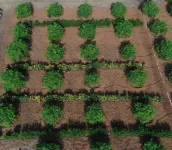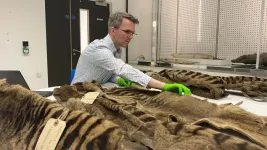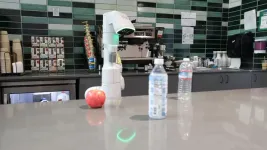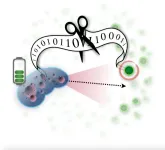(Press-News.org) Clocking up 6 or more hours of sedentary leisure time every day may double a woman’s risk of uterine fibroids before she’s gone through the menopause, suggests research published in the open access journal BMJ Open.
The risk of these benign, but potentially large and painful, womb growths seems to rise in tandem with the amount of time spent sitting or lying down during the day, the findings suggest.
Uterine fibroids are the most common benign tumours in women of childbearing age, varying in prevalence from 4.5% to 69%, say the researchers.
These growths may not produce any symptoms, but they may also be associated with abnormal bleeding, pelvic and abdominal pain, and infertility, among other things, they add.
Sedentary behaviour is associated with tumours that rely on the female hormone oestrogen, such as endometrial, ovarian, and breast cancers; uterine fibroids are also fuelled by oestrogen.
The researchers therefore wanted to find out if there might be a link between extensive sedentary leisure time and the risk of uterine fibroids.
They drew on the Yunnan cohort of the China Multi-Ethnic Cohort Study, which is a prospective community-based long term study in southwest China, involving 99,556 participants from five provinces.
The final study sample included 6623 women aged 30 to 55 who had not yet gone through the menopause.
Basic background information was collected from each of the women. This included menstrual/reproductive history, number of children and age at first birth, contraceptive use, sedentary leisure time, physical activity, diet, height and weight.
The average ages when periods first started and when giving birth for the first time were 13-16 and 20–24, respectively, and nearly 84% had more than two children.
Sedentary behaviour was classified as 1.5 or fewer metabolic equivalent of task (MET) hours/day when sitting or lying down. METs express how much energy in calories is expended per hour of physical activity.
Participants were asked to specify how much time they spent playing board games, on screen time, reading, knitting and other similar activities and were then divided into four sedentary leisure time groups: under 2 hours/day; 2–3.99 hours/day; 4–5.99 hours/day; and 6 or more hours/day.
Around 6 out of 10 (61%) of the women clocked up 2–3.99 hours/day of sedentary leisure time.
In all, 562 (8.5%) of the women had uterine fibroids, the prevalence of which increased with age. Rates were highest (2.5 times higher) among those aged 50 and older.
Weight (BMI), number of live births (more than 2), menstrual status, time since last live birth (13-17 years onwards), physical activity and sedentary leisure time were all associated with uterine fibroids.
But the more sedentary leisure time spent, the greater the risk of uterine fibroids seemed to be. And after accounting for potentially influential factors, sedentary leisure time of 6 or more hours a day was associated with a risk twice that of women who clocked up fewer than 2.
While sedentary leisure time wasn’t associated with the prevalence of fibroids in premenopausal women, it was associated with the prevalence of fibroids in perimenopausal women: the risk was 5 times higher among those who clocked up 6 or more sedentary leisure hours a day than it was in those who clocked up fewer than 2 hours.
This is an observational study, and as such, can’t establish causal factors. And the study relied on subjective assessment for many of the factors, point out the researchers.
But one possible explanation for the observed associations might be that sedentary behaviour is related to obesity, which is a risk factor for uterine fibroids, say the researchers. Both sedentary behaviour and obesity increase the body’s oestrogen level.
Other possible explanations include the known associations between sedentary behaviour and metabolic disorders, chronic inflammation, and vitamin D deficiency, they suggest.
“This cross-sectional study, based on the natural population, showed that [sedentary leisure time] has a linear positive correlation with [uterine fibroids], indicating that [it] may be an independent risk factor,” they conclude.
END
6+ hours/day of sedentary leisure time linked to doubling in fibroids risk
Risk seems to be linear in women who’ve not yet gone through the menopause
2023-11-29
ELSE PRESS RELEASES FROM THIS DATE:
Increase in the number of people identifying as transgender in the UK
2023-11-29
The number of people identifying as transgender in their GP records in the UK has increased between 2000 and 2018, finds a new study led by UCL researchers.
The research, published in BMJ Medicine, is the first large-scale study in the UK to estimate the number of people whose gender identity is different to their sex assigned at birth.
To do this, the team reviewed anonymised data from 7 million individuals aged 10 to 99 years, from IQVIA Medical Research Data, a UK primary care database, between 2000 and 2018.
Researchers looked for diagnostic codes that suggested patients had spoken to their GP about ...
Flower power on Indian farms helps bees and boosts livelihoods
2023-11-29
Planting flowers beside food crops on farms in India attracts bees, boosts pollination and improves crop yield and quality, researchers have found.
The research, the first Indian study of its kind, is published today (Monday, 28 November) in the Journal of Applied Ecology and was carried out in South India by ecologists from the University of Reading, UK, and the M S Swaminathan Research Foundation, India.
The scientists focused on the Moringa crop, a nutrient-rich "superfood," and its essential pollinators – bees.
By planting companion marigold flowers and ...
Historical violence in Tasmania: Victorian collector traded human Aboriginal remains for scientific accolades, study reveals
2023-11-29
A Hobart-based solicitor built his reputation as “the foremost scientist in the colony” in the mid-1800’s, despite limited contributions to scientific knowledge.
Morton Allport achieved his status by obtaining the bodily remains of Tasmanian Aboriginal people and Tasmanian tigers, also known as thylacines, and sending them to collectors in Europe – specifically asking for scientific accolades in return.
This took place in the context of a genocide against the Tasmanian Aboriginal peoples, and persecution of the thylacine that eventually led to its extinction.
The new research by Jack Ashby, Assistant Director of the University Museum of Zoology, Cambridge, ...
Network of robots can successfully monitor pipes using acoustic wave sensors
2023-11-29
An inspection design method and procedure by which mobile robots can inspect large pipe structures has been demonstrated with the successful inspection of multiple defects on a three-meter long steel pipe using guided acoustic wave sensors.
The University of Bristol team, led by Professor Bruce Drinkwater and Professor Anthony Croxford, developed approach was used to review a long steel pipe with multiple defects, including circular holes with different sizes, a crack-like defect and pits, through a designed inspection path to achieve 100% detection coverage for a defined reference defect.
In the study, published today in NDT and E International, ...
How do you make a robot smarter? Program it to know what it doesn’t know
2023-11-29
Modern robots know how to sense their environment and respond to language, but what they don’t know is often more important than what they do know. Teaching robots to ask for help is key to making them safer and more efficient.
Engineers at Princeton University and Google have come up with a new way to teach robots to know when they don’t know. The technique involves quantifying the fuzziness of human language and using that measurement to tell robots when to ask for further directions. Telling a robot to pick ...
Researchers working to develop next-generation polymer membranes for sustainable materials science
2023-11-28
Michele Galizia, a President’s Associates Presidential Professor in the School of Sustainable Chemical, Biological and Materials Engineering at the University of Oklahoma, is leading a research team that recently received a grant from the U.S. Department of Energy that will develop improved polymer membranes to advance molecular separation and related materials science.
“We currently separate chemicals, gases and liquids using a thermal-based distillation technology that is very expensive to operate and consumes the equivalent of eight GJ of electricity per person on the planet per year,” ...
Researchers have applied the theory of semantic information to a realistic model capturing attributes of living systems—and found the critical point where information matters for survival
2023-11-28
Living systems—unlike non-living or inanimate objects—use information about their surrounding environment to survive. But not all information from the environment is meaningful or relevant for survival. The subset of information that is meaningful, and perhaps necessary for being alive, is called semantic information.
In a new paper published in PRX Life, University of Rochester physicists and their coauthors have, for the first time, applied this theory of semantic information to a well-known ...
Growing microtumors in a dish helps rapidly identify genes that drive tumor growth
2023-11-28
Researchers have identified a new way to screen genes that cause several different types of cancers to grow, identifying particularly promising targets for precision oncology in oral and esophageal squamous cancers.
The study, published in this month’s issue of Cell Reports, used 3-dimensional models of organ tissues called organoids to identify and test potential gene targets from The Cancer Genome Atlas.
“There’s a tremendous amount of data in The Cancer Genome Atlas, ...
New research compares five retinoids for anti-photoaging therapy
2023-11-28
Over the past decades, increasing evidences have demonstrated that five retinoids, including retinol (ROL), retinol acetate (RAc), retinol propionate (RP), retinol palmitate (RPalm), and hydroxypinacolone retinoate (HPR), can be potential therapeutic agents for skin photoaging. However, therapeutic efficacies and biosafety have never been compared to these compounds. This study aimed to determine the optimal retinoid type(s) for anti-photoaging therapy both in vitro and in vivo.
The data demonstrated that four retinoids (RPalm, RP, HPR and ROL) but not RAc were effective for anti-photoaging treatment at 5 μg/mL in vitro, with action mechanisms associated with antioxidative, ...
Can health, lifestyle changes protect elders from Alzheimer's?
2023-11-28
As more medications move toward federal approval for Alzheimer’s disease, a new study led by researchers at UC San Francisco and Kaiser Permanente Washington has found that personalized health and lifestyle changes can delay or even prevent memory loss for higher-risk older adults.
The two-year study compared cognitive scores, risk factors and quality of life among 172 participants, of whom half had received personalized coaching to improve their health and lifestyle in areas believed to raise the risk of Alzheimer’s, such as uncontrolled diabetes and physical inactivity. These participants were ...
LAST 30 PRESS RELEASES:
Low daily alcohol intake linked to 50% heightened mouth cancer risk in India
American Meteorological Society announces Rick Spinrad as 2026 President-Elect
Biomass-based carbon capture spotlighted in newly released global climate webinar recording
Illuminating invisible nano pollutants: advanced bioimaging tracks the full journey of emerging nanoscale contaminants in living systems
How does age affect recovery from spinal cord injury?
Novel AI tool offers prognosis for patients with head and neck cancer
Fathers’ microplastic exposure tied to their children’s metabolic problems
Research validates laboratory model for studying high-grade serous ovarian cancer
SIR 2026 delivers transformative breakthroughs in minimally invasive medicine to improve patient care
Stem Cell Reports most downloaded papers of 2025 highlight the breadth and impact of stem cell research
Oxford-led study estimates NHS spends around 3% of its primary and secondary care budget on the health impacts of heat and cold in England
A researcher’s long quest leads to a smart composite breakthrough
Urban wild bees act as “microbial sensors” of city health.
New study finds where you live affects recovery after a hip fracture
Forecasting the impact of fully automated vehicle adoption on US road traffic injuries
Alcohol-related hospitalizations from 2016 to 2022
Semaglutide and hospitalizations in patients with obesity and established cardiovascular disease
Researchers ‘listen in’ to embryo-mother interactions during implantation using a culture system replicating the womb lining
How changing your diet could help save the world
How to make AI truly scalable and reliable for real-time traffic assignment?
Beyond fragmented markets: A new framework for efficient and stable ride-pooling
Can shape priors make road perception more reliable for autonomous driving?
AI tracks nearly 100 years of aging research, revealing key trends and gaps
Innovative techniques enable Italy’s first imaging of individual trapped atoms
KIER successfully develops Korea-made “calibration thermoelectric module” for measuring thermoelectric device performance
Diversifying US Midwest farming for stability and resilience
Emphasizing immigrants’ deservingness shifts attitudes
Japanese eels, climate change, and river temperature
Pusan National University researchers discover faster, smarter heat treatment for lightweight magnesium metals
China’s 2024 Gastroenterology Report: marked progress in endoscopy quality and disease management
[Press-News.org] 6+ hours/day of sedentary leisure time linked to doubling in fibroids riskRisk seems to be linear in women who’ve not yet gone through the menopause





